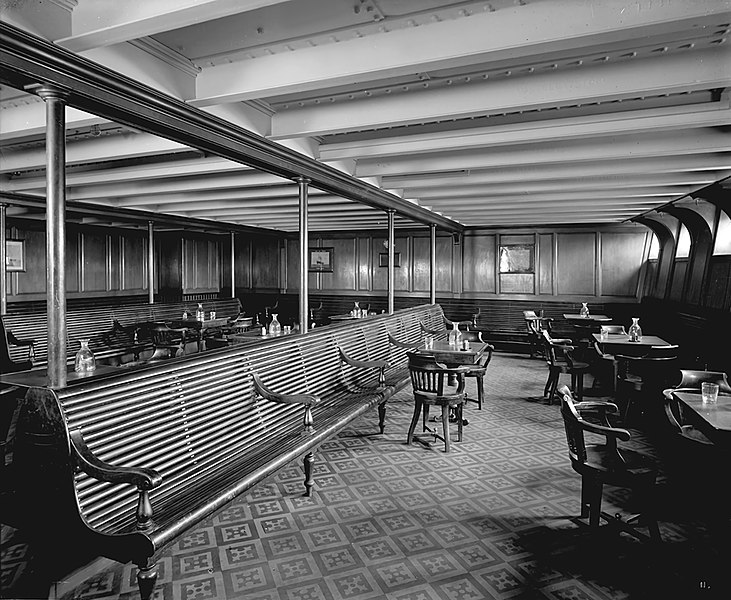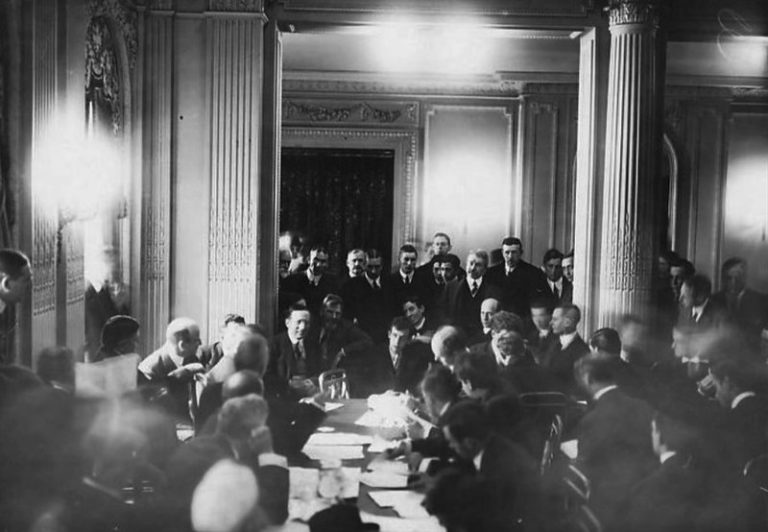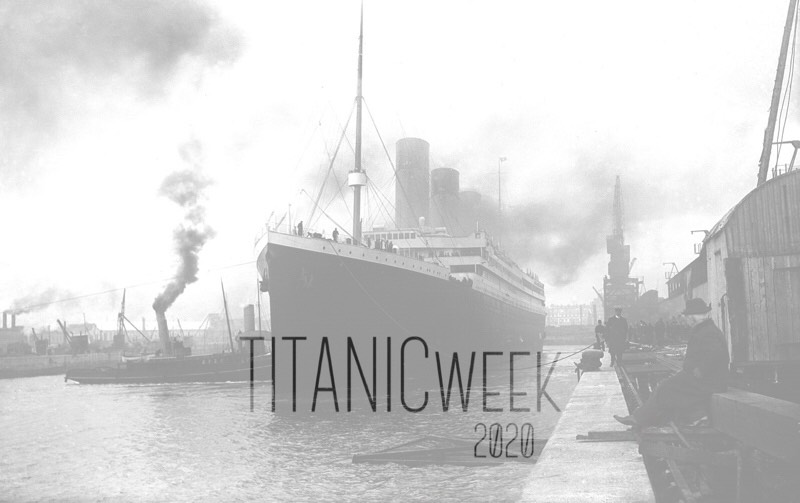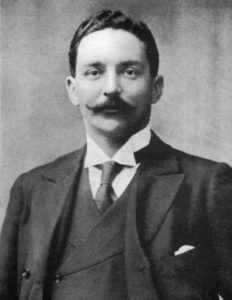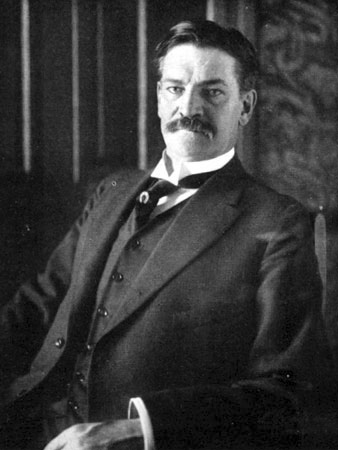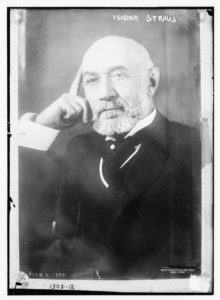"Honor and Glory Crowning Time": The Grand Staircase
It is a truth universally acknowledged that one cannot think of Titanic without seeing, in the mind’s eye, the Grand Staircase.
And for good reason. The Grand Staircase was installed in all three Olympic-class vessels, and was the opulent centerpiece of each ship.
Titanic’s Grand Staircase, in particular, has achieved an almost otherworldly status, though, because it’s so often recreated in media.
Despite the impression this often gives, the Grand Staircase was, of course, designed to do what any proper staircase does: functionally connect floors.
The Grand Staircase reached from Boat Deck all the way to E Deck. Elevators were also located just forward of the Staircase from A through E Decks.
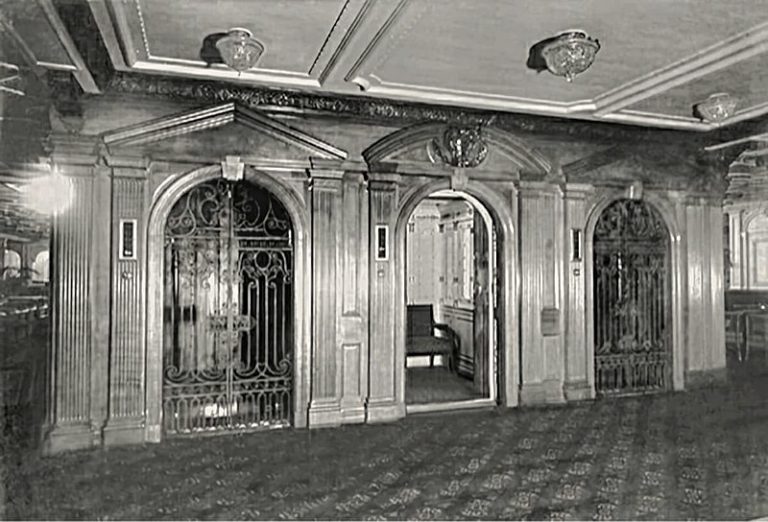
First-Class elevators on RMS Olympic, circa 1911.
The Grand Staircase was constructed from Irish oak in the William & Mary style.
And at its top was an astonishing and elaborate dome made from glass and wrong iron, from the center of which hung a gilted crystal chandelier.
“It was an object of great splendour,” proclaimed the White Star Line. “A fitting crown as it were these the largest and finest steamers in all the world.”
The glass dome was backlit during the evening hours thanks to a protective box that was installed around it, to protect it from the worst of the sea elements.
On A Deck, the floor of the landing was comprised of linoleum tiles, which were milk-colored and interspersed with onyx medallions. Blue sofas and armchairs, as well as potted palms, decorated this landing, as well as each subsequent level of the Grand Staircase.
There was also a piano on the Boat Deck level, so the band could entertain in the stairwell.
At the base of the Grand Staircase on A Deck was a bronze cherub holding a torch; replicas are thought to have decorated the bases of B and C Decks. On D Deck, the base of the Staircase boasted an electrically lit gilt candelabra.

Color illustration of Grand Staircase from White Star Brochure, circa 1911.
White Star released a promotional brochure in 1911 for both Olympic and Titanic, and did they love them some Grand Staircase.
We leave the deck and pass through one of the doors which admit us to the interior of the vessel, and, as if by magic, we at once lose feeling that we are on board a ship, and seem instead to be entering the hall of some great house on shore. Dignified and simple oak panelling covers the walls, enriched in a few places by a bit of elaborate carved work...
In the middle of the hall rises a gracefully curving staircase, its balustrade supported by light scrollwork of iron with occasional touches of bronze, in the form of flowers and foliage. Above all a great dome of iron and glass throws a flood of light down the stairway...
Looking over the balustrade, we see the stairs descending to many floors below, and on turning aside we find we may be spared the labour of mounting or descending by entering one of the smoothly-gliding elevators which bear us quickly to any other of the numerous floors of the ship we may wish to visit.
As written in the White Star promotional brochure "Olympic" / & "Titanic" / Largest Steamers in the World," 1911.
The portion of the Staircase that you’re probably envisioning right now—with the glass dome and the famous clock—was A Deck, which was considered dual-level.
The interior balcony with the ornate arched windows and potted ferns (that looked down onto A Deck with the dome directly overhead) was Boat Deck.

Grand Staircase, Boat Deck Level, on RMS Olympic. Taken by William Herman Rau.
The Grand Staircase was accessible exclusively to First-Class passengers. It functioned as the point of entry to First-Class public rooms and staterooms; the rooms that could be accessed from each deck were as follows.
Boat Deck: opposing corridors granted access to the Officers Quarters and the Marconi Room. The entrance to the First-Class Gymnasium was next door to the Starboard entrance to the Grand Staircase.
A Deck: access to the Reading & Writing Room, as well as the Lounge, which were entered through revolving doors. Also granted entrance to the Promenade Deck, and First-Class staterooms.
B Deck: Both of the “Millionaires’ Suites” were accessible from B Deck, as well as the most lavish of the First-Class staterooms.
C Deck: The Purser’s office, as well as the Enquiries office, were immediately off the Staircase to the Starboard side. More First-Class staterooms were also accessible via companionways.
D Deck: Opened directly onto the Reception Room, and the Dining Saloon was adjacent to that. First-Class staterooms were once again accessible behind the staircase.
E Deck: Only cabins were accessible via E Deck. From here, a modest staircase could be taken down to F Deck to get to certain athletics facilities that were located on F Deck, such as the swimming pool and the Turkish baths.
The well-known ornate clock on A Deck, which was located directly below the glass dome, actually had a name, so to speak. It was called “Honour and Glory crowning Time.”
The clock was carved from solid oak, and its design was inspired by a "monumental" chimney that had been designed for none other than Napoleon Bonaparte.
That chimney was illustrated in the publication “Recueil de decorations interieures” in 1812; it was made of white marble and gilt bronze, and was installed in 1810. Unfortunately, it was destroyed in a fire in 1871.

Plate of "monumental" chimney, designed for Napoleon Bonaparte by Percier and Fontaine, 1812.
“Honour and Glory crowning Time” was a so-called slave clock.
This meant that it, along with 24 other clocks within the ship, were beholden to a master clock located in the wheel house that all worked in synchronity. There were two master clocks on Titanic, each of which controlled 25 slave clocks.
A man by the name of Charles Wilson carved the central portion of the clock.
Mr. Wilson recalled that when Titanic departed from Belfast on April 3, 1912, the timepiece was not ready. A circular mirror, therefore, was installed as a holdover until the clock face was ready.
Charles Wilson, therefore, reasoned that the completion of clock had to have occurred while Titanic was docked in Southampton, between April 3, 1912, and her departure on April 10.

Grand Staircase of RMS Olympic, first published in "The Shipbuilder" in 1911.
While A Deck had the allegorical clock, Decks B through E had oil paintings installed on their landings.
There was also an Aft Grand Staircase located between the third and fourth funnels; unlike its counterpart, it only reached only from A Deck to C Deck. From the Aft Grand Staircase, passengers could reach the Smoking Room and Lounge, as well as the A La Carte Restaurant the Cafe Parisien.
The Grand Staircase does not exist within the wreck. It is thought that each segment of the Staircase broke apart and floating out during the sinking, or was shattered by the hydraulic blast caused by the bow’s impact with the seabed. Otherwise, it simply rotted away prior to the discovery of the wreck in 1985.
Where the Grand Staircase once was, is a deep and lightless well. But this has allowed for quite convenient ROV entry into Decks A through D.
Recognizable elements of the foyers that surrounded the Grand Staircase are still visible and intact, such as ceiling fixtures and a few carved pillars, as well as oak beams.
The Aft Grand Staircase was summarily decimated, because it was located where Titanic ruptured and broke.
It should be noted that all of the photos included herein are of Titanic's elder sister, the RMS Olympic. No photos of Titanic's Grand Staircase are known to exist.








